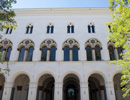Modes of Modality
 Munich, 10-12th May 2012, German Linguistics Department, LMU Munich
Munich, 10-12th May 2012, German Linguistics Department, LMU Munich
The aim of both conferences ("Function(s) of modality" and "Modality, Typology, and Universal Grammar") is to uncover the whole range of functions and patterns of modality as they are currently known and discussed. The main questions are: What is modality? What are the subtypes of modality? And what are the main characteristics of these subtypes concerning their degree of complexity and their hierarchical order?
Function(s) of Modality (Treffen des Arbeitskreises "Modalität im Deutschen")
The meetings of the international working group on "Modality in German" (Arbeitskreis für "Modalität im Deutschen") focus on different subareas of modality. This time, the aim is to obtain an overall view and provide a definition for the function(s) of modality and its subtypes in German which is able to stand the test in cross-linguistic comparison and to provide a solid basis for the understanding of modality within the architectural structure of grammatical categories. [more]
Modality, Typology, and Universal Grammar
The conference aims at a universal definition of modality or "illocutionary force" that is strong enough to capture the whole range of the different subtypes and varieties of modality in different languages of the world. The conference is part of a research project on "Un-Cartesian Linguistics". The aim of this project is to design an alternative approach to Cartesian/rationalist models of Universal Grammar. It is a functional approach being rooted in the UG of Modist Universal Grammar of the late 13th century and revived by Charles S. Peirce and Roman Jakobson. The aim of the conference is thus to treat modality as part of Universal Grammar, however by avoiding the dead ends of naïve formalism as well as of simplistic anti-functionalism or miss-understood functionalisms. [more]

